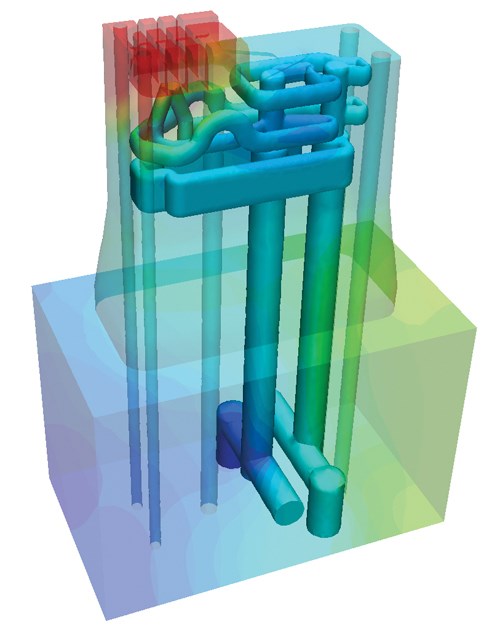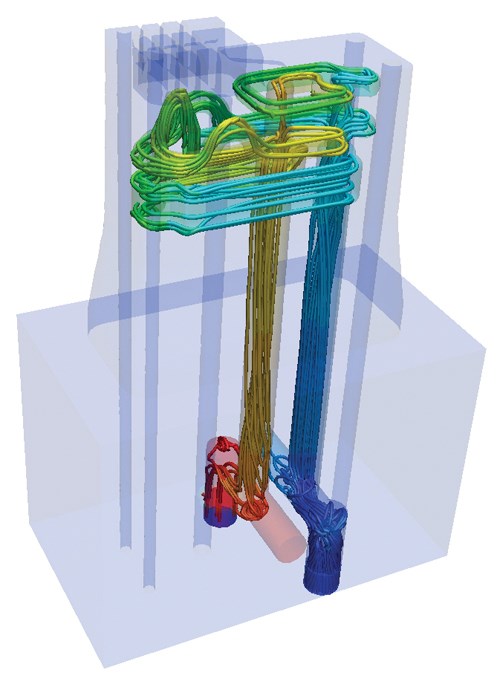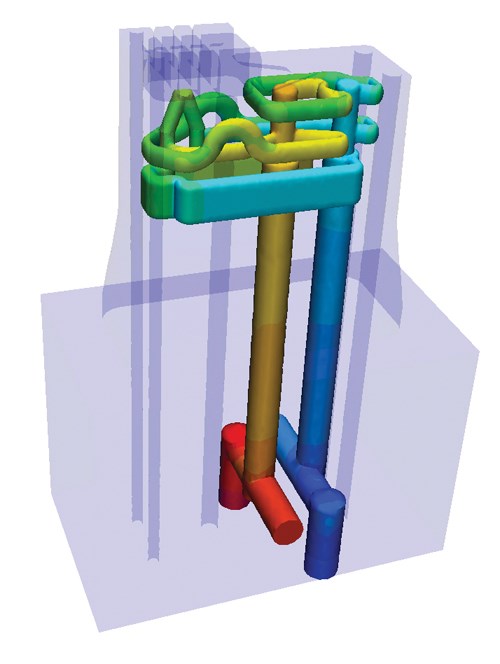Mold Cooling Breakthroughs
“Radical” is not a word one expects to hear from a plastic injection molding company.
“Radical” is not a word one expects to hear from a plastic injection molding company. Yet, it pops up more than once in conversation with Paul Mailloux, CAD/CAM application engineer for NyproMold.
NyproMold designs and builds high-precision molds used for products such as cell phones, electronic equipment, and consumer and medical devices. At NyproMold, radical is most often used to describe mold cooling breakthroughs made possible by upfront computational fluid dynamics (CFD) using CFdesign software and the latest in laser sintering technology.
Removing Guesswork
CFD, FEA and injection molding simulation software has always been part of the NyproMold design and engineering process, helping the company make decisions and predictions prior to actual manufacturing. But with CFdesign software from Blue Ridge Numerics, CFD is factored in at the early product development stages, where it is most valuable in determining the feasibility of design options.
Integration between CFdesign and Pro/ENGINEER software used by NyproMold allows the company to conduct iterative design studies without any translation, conversion or data loss. Volumes, void-filling, boundary conditions and material properties are assigned automatically in CFdesign. Associativity of all geometry is maintained as the assembly moves between CAD and CFD iterations.
The close relationship between CAD and upfront CFD is enabling NyproMold to replace conjecture with confirmation.
“NyproMold brings many, many years of cooling expertise to the table and can often predict what is needed for good cooling circuits,” says Mailloux. “CFdesign can confirm and/or correct the original predictions. It has replaced guesswork with accurate, concise data that gives us the confidence we need to design and build molds right the first time. This is extremely important to us as there is never enough time or capital to do the same job twice.”
Manufacturing for Radical Cooling
While CFdesign provides the ability to explore new designs on the front end, laser sintering enables NyproMold to fully realize those designs in the physical world.
Laser sintering is a fusion process that uses 3D CAD data to produce large-volume components layer-by-layer. Complex component geometries can be manufactured without tools, and optimally cooled mold inserts allow parts to be produced without distortion. Parts produced with laser sintering are comparable to traditionally machined parts in terms of steel density and hardness, according to Mailloux.
“Laser sintering technology allows us to create parts and inserts that contain complex conformal cooling circuits that are otherwise impossible to create with conventional manufacturing techniques,” says Mailloux.
Conformal cooling is a methodology that uniformly cools complex cores and shapes in molds, offering large savings in cycle times and increased part quality.
Reducing Cycle Times by 40 Percent
Mailloux cites a before-and-after contrast for a high-cavitation tool as an example of the big dividends from combining upfront CFD and laser sintering.
The tool was initially designed with traditional circuits before NyproMold implemented CFdesign software and the laser sintering system. The second time the tool was designed, a new cooling circuit was developed after using CFdesign to experiment with several conformal cooling scenarios.
“The ability to overlay and compare various iterations of cooling circuits within CFdesign to determine the best cooling concept was extremely valuable to us,” says Mailloux. “Then, there were the fast processing and quick results: Even during the computations, dynamic results were available for review and interaction. This enabled early decision-making prior to actually finalizing the computations.”
Using the CFdesign simulations, NyproMold confirmed the best cooling concepts and perfected the cooling circuits prior to manufacturing.
“We basically removed all guesswork and rework upfront, and were able to then take full advantage of laser sintering at the back end,” says Mailloux.
The improved cooling of the final high-cavitation tool reduced cycle time by more than 40 percent, from 23 to 16 seconds.
“In terms of injection molding, this is a radical improvement amounting in tremendous annual savings to our customer,” says Mailloux. “Only CFdesign could have led us down this decision-making course to reach such a successful result.”
Impact on Customer Satisfaction
Although customers rarely see upfront CFD analyses, Mailloux says they have a major impact on customer satisfaction.
“We have a far greater confidence that timelines will be met and first-off parts will be acceptable,” he says. “We are able to provide the best cooling scenarios and therefore improved cycle time, part quality and process windows that would otherwise be unachievable with mere guesswork.”
With the combined capabilities of upfront CFD and laser sintering, NyproMold is adding an unexpected new meaning to “radical,” making it synonymous with “rest assured.”
Related Content
How to Manage Wall Thickness Changes in Your Mold Design
To ensure even filling and cooling, consider wall section transitions, corners and fillets, ribs and bosses, lip and rim designs and CAE flow simulation software.
Read MoreLeading Mold Manufacturers Share Best Practices for Improving Efficiency
Precise Tooling Solutions, X-Cell Tool and Mold, M&M Tool and Mold, Ameritech Die & Mold, and Cavalier Tool & Manufacturing, sit down for a fast-paced Q&A focused on strategies for improving efficiencies across their operations.
Read MoreFour Micro Tooling Considerations
Issues involving gating, ejection, mold splits and direction of pull are of special concern when it comes to micro tooling.
Read MoreHow to Select a Mold Temperature Controller
White paper shares how cooling channel analysis, which collects maximum pressure drop, total flow rate and heat dissipation, eases the performance evaluation of mold temperature controllers.
Read MoreRead Next
Reasons to Use Fiber Lasers for Mold Cleaning
Fiber lasers offer a simplicity, speed, control and portability, minimizing mold cleaning risks.
Read MoreAre You a Moldmaker Considering 3D Printing? Consider the 3D Printing Workshop at NPE2024
Presentations will cover 3D printing for mold tooling, material innovation, product development, bridge production and full-scale, high-volume additive manufacturing.
Read MoreHow to Use Continuing Education to Remain Competitive in Moldmaking
Continued training helps moldmakers make tooling decisions and properly use the latest cutting tool to efficiently machine high-quality molds.
Read More
















.jpg;maxWidth=300;quality=90)












